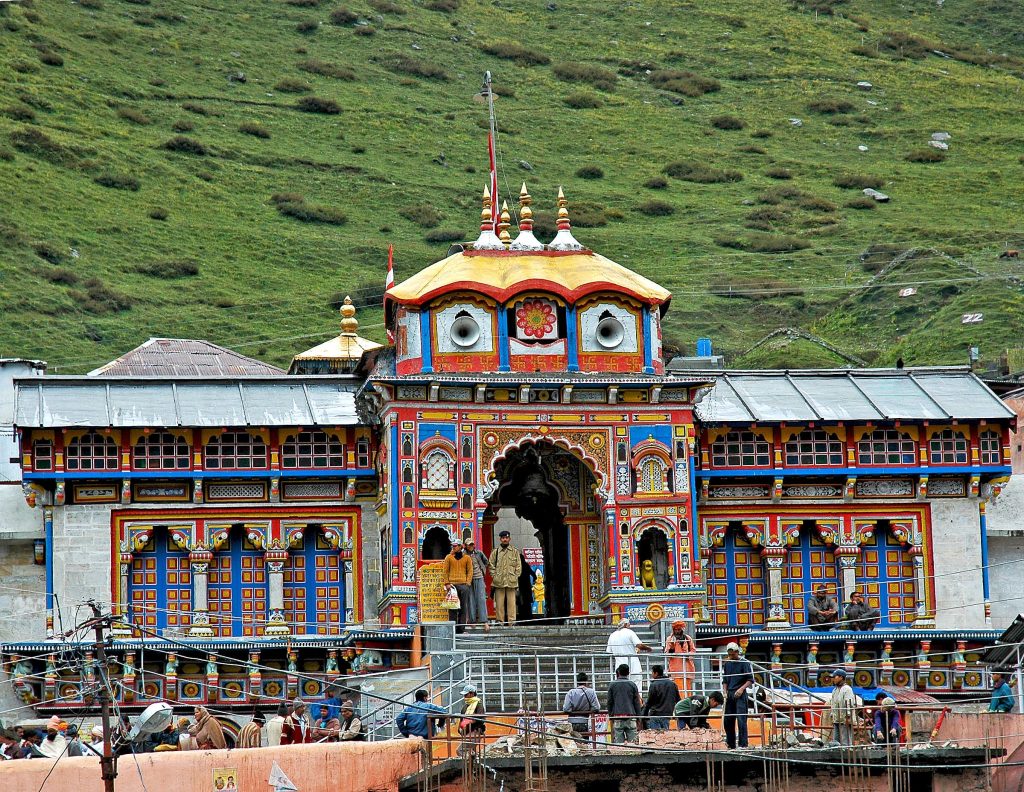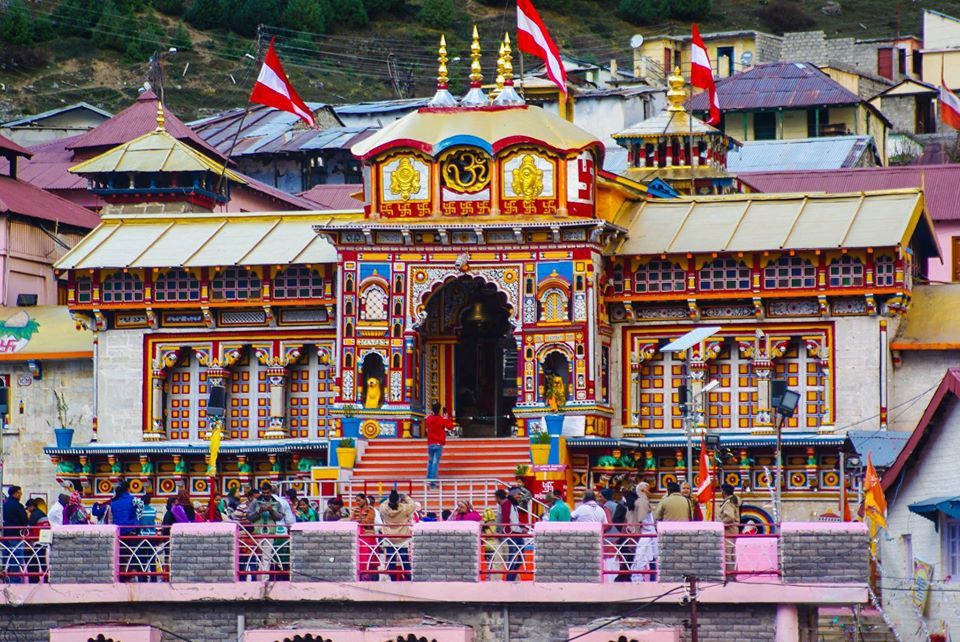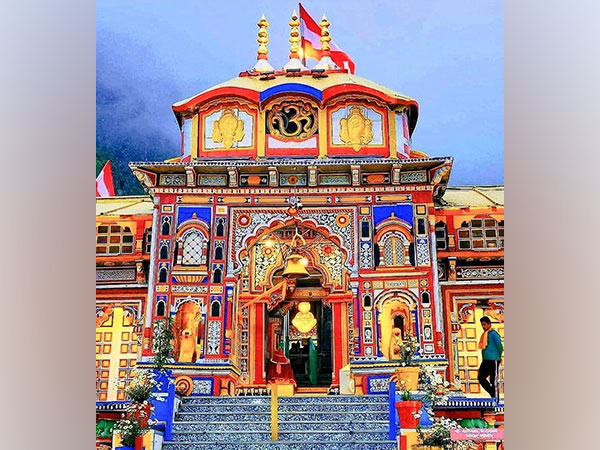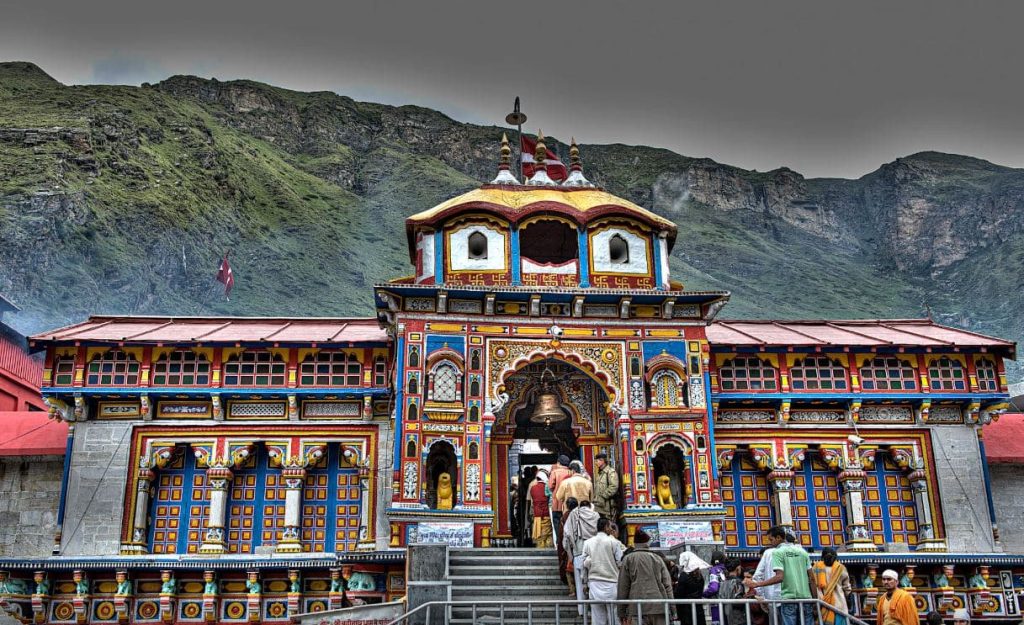BADARINATH TEMPLE
Badarinath or Badarinarayana Temple is a Hindu temple dedicated to Vishnu. It is situated in the town of Badrinath in Uttarakhand, India. The temple is also one of the 108 Divya Desams dedicated to Vishnu—holy shrines for Vaishnavas—who is worshipped as Badrinath. It is open for six months every year (between the end of April and the beginning of November), because of extreme weather conditions in the Himalayan region. The temple is located in Garhwal hill tracks in Chamoli district along the banks of Alaknanda River. It is one of the most visited pilgrimage centers of India, having recorded 2.8 million (28 lakh) visits in just 2 months in 2022. It is one of the Char Dham pilgrimage sites.

The image of the presiding deity worshipped in the temple is a 1 ft (0.30 m), the black granite deity of Vishnu in the form of Badrinarayan. The deity is considered by many Hindus to be one of eight svayam vyakta kshetras, or self-manifested deities of Vishnu. Mata Murti Ka Mela, which commemorates the descent of river Ganges on mother earth, is the most prominent festival celebrated in the Badrinath Temple. Although Badrinath is located in North India, the head priest, or Rawal, is traditionally a Nambudiri chosen from the South Indian state of Kerala. The temple was included in the Uttar Pradesh state government Act No. 30/1948 as Act no. 16,1939, which later came to be known as “Shri Badarinath and Shri Kedarnath Mandir Act”. The committee nominated by the state government administers both the temples and has seventeen members on its board.The temple is mentioned in ancient religious texts like Vishnu Purana and Skanda Purana. It is glorified in the Naalayira Divya Prabandham, an early medieval Tamil canon of the Alvar saints from the 6th–9th centuries CE.

The temple is located in Garhwal hill tracts along the banks of the Alaknanda River in Chamoli district in Uttarakhand. The hill tracts are located 3,133 m (10,279 ft) above the mean sea level. The Nar Parbat mountain is located opposite to the temple, while the Narayana Parbat is located behind the Neelkanth peak. Adi Shankara established Badrinath as a pilgrimage site in the ninth century. The temple has three structures: the Garbhagriha (sanctum), the Darshan Mandapa (worship hall), and Sabha Mandapa (convention hall). The conical-shaped roof of the sanctum, the garbhagriha, is approximately 15 m (49 ft) tall with a small cupola on top, covered with a gold gilt roof. The facade is built of stone and has arched windows. A broad stairway leads up to the main entrance, a tall, arched gateway. Just inside is a mandap, a large, pillared hall that leads to the sanctum, or main shrine area. The walls and pillars of the hall are covered with intricate carvings.

There is no historical record about the temple, but there is a mention of the presiding deity Badrinath in Vedic scriptures (c. 1750–500 BCE). According to some accounts, the shrine was worshipped in some form in the Vedic period. Later, during Ashoka’s reign, because of the spread of Buddhism, this shrine might have been converted into a Buddhist shrine. The temple was a Buddhist shrine till the 8th century and Adi Shankara revived the shrine and converted it to a Hindu temple. The architecture of the temple resembling that of a Buddhistvihara (temple) and the brightly painted facade which is atypical of Buddhist temples leads to the argument. Other accounts relate that it was originally established as a pilgrimage site by Adi Shankara in the ninth century. It is believed that Shankara resided in the place for six years from 814 to 820 CE. He resided six months in Badrinath and the rest of the year in Kedarnath. Hindu followers assert that he discovered the deity of Badrinath in the Alaknanda River and enshrined it in a cave near the Tapt Kund hot springs. A traditional story asserts that Shankara expelled all the Buddhists in the region with the help of the Parmar ruler king Kanak Pal. The hereditary successors of the king governed the temple and endowed villages to meet its expenses. The income from a set of villages on the route to the temple was used to feed and accommodate pilgrims. The Parmar rulers held the title “Bolanda Badrinath”, meaning speaking Badrinath. They had other titles, including Shri 108 Basdrishcharyaparayan Garharaj Mahimahendra, Dharmabibhab, and Dharamarakshak Sigamani.

The throne of Badrinath was named after the presiding deity; the king enjoyed ritual obeisance by the devotees before proceeding to the shrine. The practice was continued until the late 19th century. During the 16th century, the King of Garhwal moved the murti to the present temple. When the state of Garhwal was divided, the Badrinath temple came under British rule but the king of Garhwal continued as the chairman of the management committee. The selection of priest is done after consultation between Garhwal and Travancore royal families. The temple has undergone several major renovations due to its age and damage by an avalanche. In the 17th century, the temple was expanded by the Kings of Garhwal. After significant damage during the great 1803 Garhwal earthquake, it was largely rebuilt by the King of Jaipur. It was still under renovation as late as the 1870s but these were completed by the time of the First World War. At that time, the town was still small, consisting of only the 20-odd huts housing the temple’s staff, but the number of pilgrims was usually between seven and ten thousand. The Kumbh Mela festival held every twelve years raised the number of visitors to 50,000. The temple also enjoyed revenue from the rents owed to it by various villages bequeathed by various rajas.
Thanks for reading.